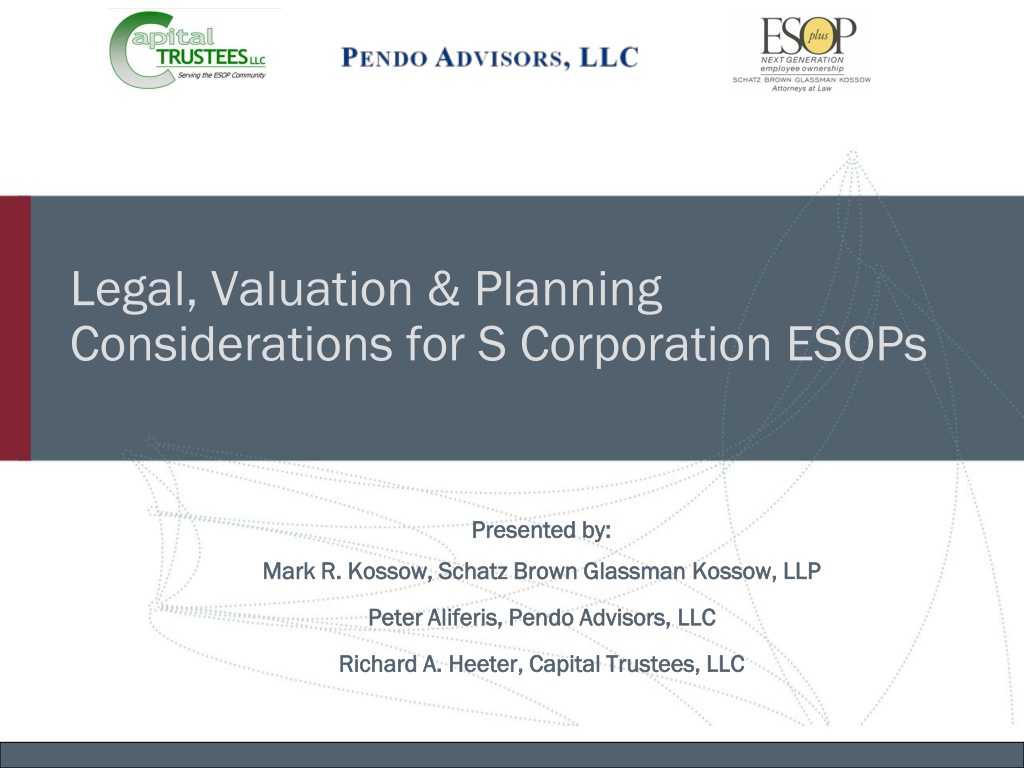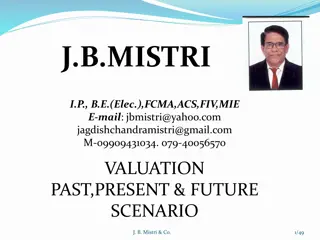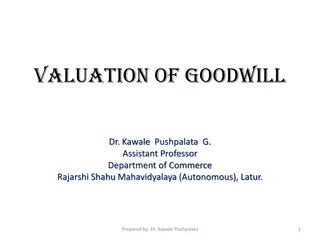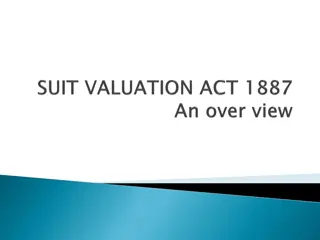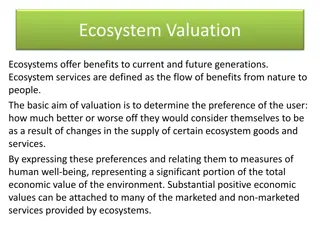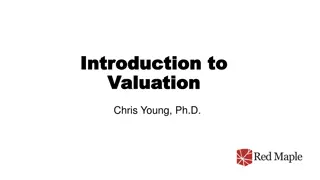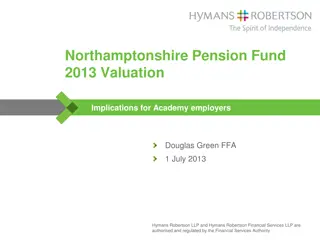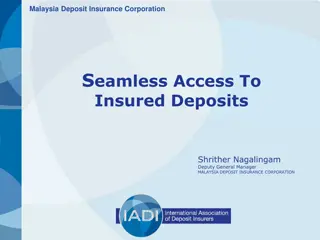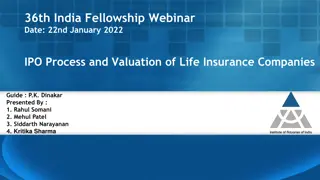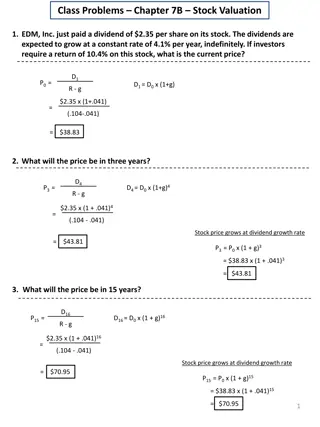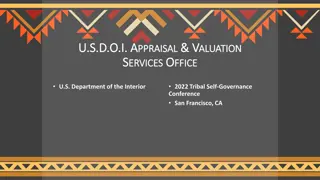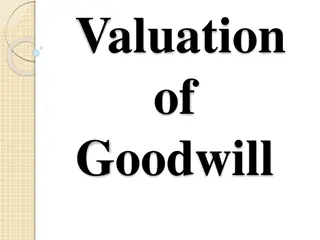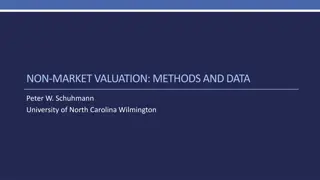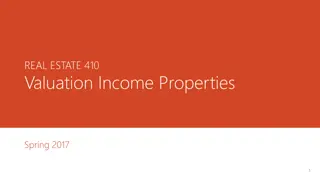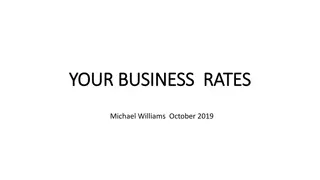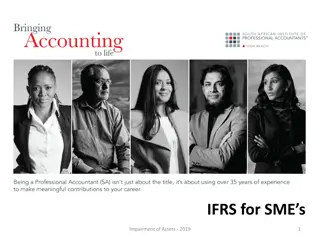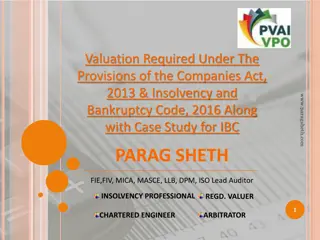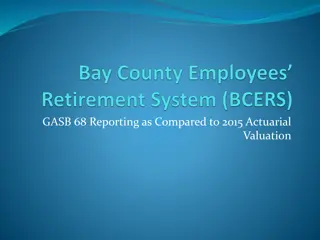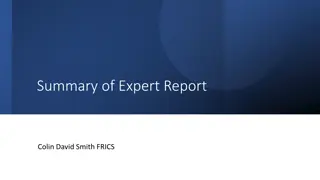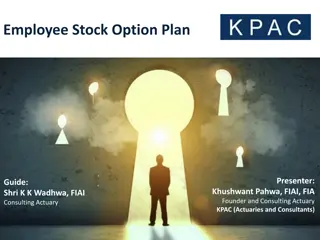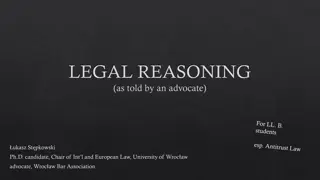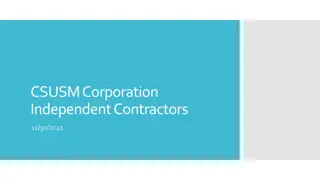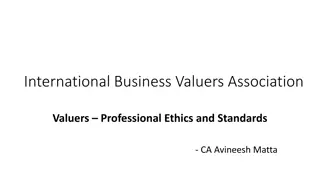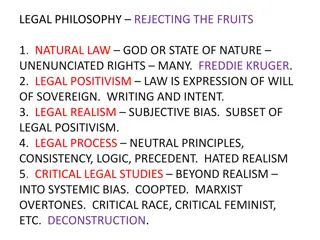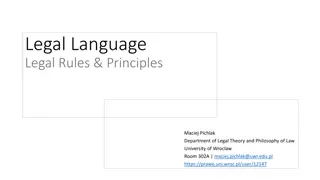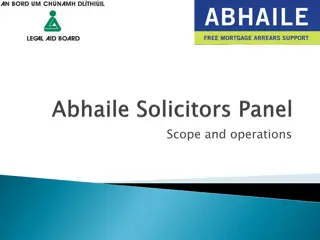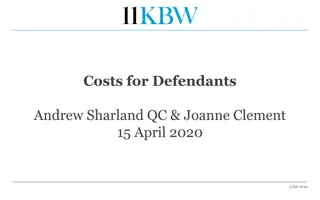Legal, Valuation & Planning Considerations for S Corporation ESOPs
S Corporations combined with Employee Stock Ownership Plans (ESOPs) offer various benefits like flexible transaction structures, tax advantages, and employee retirement benefits. This presentation covers the requirements for S Corporations, switching to S Corporation status, ESOP rules, benefits, stock sales to ESOPs, Valuation considerations, and more.
Download Presentation

Please find below an Image/Link to download the presentation.
The content on the website is provided AS IS for your information and personal use only. It may not be sold, licensed, or shared on other websites without obtaining consent from the author. Download presentation by click this link. If you encounter any issues during the download, it is possible that the publisher has removed the file from their server.
E N D
Presentation Transcript
Legal, Valuation & Planning Considerations for S Corporation ESOPs Presented by: Presented by: Mark R. Kossow, Schatz Brown Glassman Mark R. Kossow, Schatz Brown Glassman Kossow, LLP Kossow, LLP Peter Aliferis, Pendo Advisors, Peter Aliferis, Pendo Advisors, LLC LLC Richard A. Richard A. Heeter Heeter, Capital Trustees, LLC , Capital Trustees, LLC 1 1
Introduction Introduction S Corporations are a very common type of entity for closely-held businesses Many business owners have utilized or are considering using an employee stock ownership plan (ESOP) as an exit/transition strategy The combination of an S Corporation and ESOP can provide tremendous benefits Flexible transaction structure and financing Tax benefits to company and selling shareholders Employee retirement benefits 2 2
Introduction Introduction Important to understand S Corporation requirements Considerations for switching to S Corporation status ESOP rules and benefits 3 3
Overview of Topics to be Covered Overview of Topics to be Covered S qualification, election and other issues Planning for stock sales to ESOPs S Corporations partially owned by ESOPs (partial-ESOP S corporations) Valuation consideration Miscellaneous 4 4
S Qualification, Election and Other Issues S Qualification, Election and Other Issues Limitations on eligible shareholders and 100 shareholder limit Ineligible shareholders: IRAs, nonresident aliens, corporations, LLCs, partnerships, and many trusts may not own shares ESOP trust only counts as one shareholder ISSUE: Partial-ESOP S corporations need to protect S corporation status through shareholder agreements 5 5
S Qualification, Election and Other Issues S Qualification, Election and Other Issues Single class of stock requirement S corporations may have only one class of stock outstanding Under the corporation s governing provisions all outstanding shares must confer identical rights to distributions and liquidation proceeds Governing provisions include the corporate charter, articles of incorporation, bylaws, applicable state law, and binding agreements that affect distribution / liquidation proceeds Differences in voting rights are permissible 6 6
S Qualification, Election and Other Issues S Qualification, Election and Other Issues Single class of stock requirement (cont d) ISSUE: Options, warrants, shareholder agreements, etc. can inadvertently create second classes of stock, and must be carefully structured Nominal exercise prices on warrants to lenders / selling shareholders may cause warrant to be treated as a disqualifying second class of stock TEST: Taking into account all facts and circumstances (A) is the warrant/option substantially certain to be exercised; and (B) does it have a strike price substantially below FMV of the underlying stock on the issue date 7 7
S Qualification, Election and Other Issues S Qualification, Election and Other Issues Election Issues Made prior to beginning of tax year, or Made within 2 months after start of tax year Retroactive to beginning of tax year Corporation must be eligible during entire retroactive period ISSUE: With a retroactive S election it is critical to coordinate timing of sale when a 1042 election is intended Must be prior to effective date of S election 8 8
S Qualification, Election and Other Issues S Qualification, Election and Other Issues Election Issues (cont d) All shareholders at the time of the election must consent to the election New shareholders need not consent after election NOTE, for a retroactive election each person who was a shareholder at ANY time during retroactive period before the election is made (and who is not a shareholder at the time the election is made) must also consent to the election Trustee of the ESOP can consent on behalf of the ESOP Shareholder consent is binding and may not be withdrawn after a valid election is made 9 9
S Qualification, Election and Other Issues S Qualification, Election and Other Issues Tax Year Issues Issue: S corporation s tax year must be a calendar year unless corporation: Establishes a business purpose for a year other than the calendar year Agrees to make a refundable interest-free deposit with the IRS to eliminate the benefit of any tax deferral If the ESOP owns 100% of the company and ESOP trust has non-calendar fiscal year, the S corporation can adopt the same tax year (principal shareholder exception) 10 10
S Qualification, Election and Other Issues S Qualification, Election and Other Issues Qualified Subchapter S Subsidiaries (QSUBs) Must be 100% owned subsidiary Must elect S status for QSUB QSUB treated as a disregarded entity (tax treatment of the QSUB is ultimately passed through to the shareholders of the parent S corporation) 11 11
S Qualification, Election and Other Issues S Qualification, Election and Other Issues S Distributions S corporation having earnings & profits (E&P) Tax-free to extent distribution does not exceed AAA Taxable as dividend to extent distribution exceeds AAA but does not exceed E&P Remainder treated as return on basis (not taxable) and any excess over basis taxed as capital gain NOTE: company can make an election to distribute E&P first. Requires the consent of all affected shareholders 12 12
S Qualification, Election and Other Issues S Qualification, Election and Other Issues Distributions (cont d) S corporations having no E&P The distribution is first applied against basis If amount of distribution exceeds the adjusted basis of the stock, excess shall be treated as a capital gain 13 13
S Qualification, Election and Other Issues S Qualification, Election and Other Issues Termination of S status Revocation shareholders holding more than of shares of stock must consent Retroactive to beginning of the tax year if made before the 15thday of the 3rdmonth Effective on the 1stday of the following tax year if made after the 15thday of the 3rdmonth and revocation does not otherwise specify a prospective revocation date If specified, revocation is effective on such date 14 14
S Qualification, Election and Other Issues S Qualification, Election and Other Issues Termination of S status By corporation ceasing to be a small business corporation Effective as of the date in which termination event occurs Termination by reason of excess passive investment income Only applies to S corporations that used to be C corporations Passive investment income in excess of 25% of gross receipts for 3 consecutive years Effective on the first day of the first taxable year following such 3 consecutive year period 15 15
C Corporations that Become S Corporations C Corporations that Become S Corporations ISSUE: Built-In Gains (BIG) Tax Exposure to corporate level tax on net realized built-in gains for 10 [5 years for 2013] years after S election Appraising assets at the time of election helps manage this tax Accounts Receivable (accrual method rule) cash basis corporation subject to BIG tax on collections after conversion 16 16
C Corporations that Become S Corporations C Corporations that Become S Corporations Presence of C corporation E&P raises issues ISSUE: potential taxable dividends if distributions exceed AAA AAA - aggregate, undistributed taxable income of the S corporation (i.e., previously taxed S corporation earnings) Must monitor distributions to ensure that taxable dividends are not inadvertently paid 17 17
C Corporations that Become S Corporations C Corporations that Become S Corporations ISSUE: LIFO recapture tax Reserve resulting from LIFO (Last-in, First-out) inventory accounting must be recaptured and taxed when switching from C to S LIFO recapture amount is amount by which inventory computed on the FIFO (First-in, First-out) method exceeds inventory computed on the LIFO method Tax is computed on last C corporate tax return and is paid in four equal annual installments 18 18
Planning for Stock Sales to ESOPs Planning for Stock Sales to ESOPs Income Tax Deferral 100% ESOP-owned S corporation has significant tax saving opportunities No corporate-level federal tax on annual S corporation income (most states mirror this provision) Although income will be passed through to the shareholder (the ESOP), no shareholder level tax will be imposed because the ESOP is a tax-exempt entity The income tax liability will effectively be deferred until the participants in the ESOP receive their benefits 19 19
Planning for Stock Sales to ESOPs Planning for Stock Sales to ESOPs Income Tax Deferral (cont d) ESOP owns Less than 100% Tax exclusion in proportion to ESOP ownership ESOP entitled to its share of S-distributions paid if corporation makes distributions to non-ESOP shareholders to cover payment of taxes on the passed through corporate income Example ESOP owns 30% of company 2012 taxable income was $1 million Non-ESOP shareholder income allocation = $700,000. Corporation distributes $245,000 to cover federal tax liability Corporation also required to distribute $105,000 to the ESOP Cash in ESOP can be used for ESOP debt service, repurchase obligation or to purchase additional shares If cash from S distributions builds up in ESOP, it may not be available to company for investment or expansion 20 20
Planning for Stock Sales to ESOPs Planning for Stock Sales to ESOPs ISSUE: Capacity of a leveraged ESOP to carry purchase debt (Code Section 404 Limits) C corporation - contributions for principal payments on ESOP debt limited to 25% of eligible compensation, but generally no limits on contributions used to pay interest S corporations contributions for both principal and interest payments count toward limitation Amount of debt service an S corporation s payroll can support will be less than if it were a C corporation 21 21
Planning for Stock Sales to ESOPs Planning for Stock Sales to ESOPs 415 annual addition limits Generally, 415 limit is the lesser of (a) 100% of participants compensation and (b) $50,000. Includes employer contributions, employee contributions and forfeitures For C corporations only if no more than 1/3 of the employer contributions to the ESOP which are used to pay down an ESOP loan are allocated to the accounts of HCEs, then the general 415 rules do not apply with respect to annual additions attributable to forfeitures and interest payments on an exempt loan This rule does not apply to S corporations and therefore may limit the capacity of an ESOP to carry debt 22 22
Planning for Stock Sales to ESOPs Planning for Stock Sales to ESOPs Stock Redemption Transactions in S corporation ESOP companies Helps obtain capital gain / installment sale treatment for owners of non-1042 transactions ISSUE: Need to ensure that the redemption qualifies under 302 as a sale or exchange and not a 301 dividend Reduces value of corporation and stock for sale to ESOP Seller Financing (with warrants attached) permit sellers to participate in future growth 23 23
Planning for Stock Sales to ESOPs Planning for Stock Sales to ESOPs S corporation converts to C corporation to allow for 1042 election (with intent to eventually convert back to S status) ISSUE: Will 1042 transaction qualify? Shares sold to ESOP must be qualified employer securities 3 year holding period 30% rule immediately after the sale, ESOP must own at least 30% of each class of outstanding stock or at least 30% of the total value of all outstanding stock Conversion to C corporation may block S status for 5 years Built-In Gains (BIG) tax exposure upon later S election 24 24
Sale of Stock to an ESOP vs. Taxable Sale Sale of Stock to an ESOP vs. Taxable Sale ESOP Federal Tax Savings of Sale to an ESOP Taxable Sale ESOP Sale Sale Price $30,000,000 $30,000,000 Basis 5,000,000 5,000,000 Appreciation $25,000,000 $25,000,000 TAX @20% $5,000,000 $0 Net Proceeds $25,000,000 $30,000,000 25 25
Financing Issues Financing Issues Financing Issues One of the most critical elements to implementing an ESOP is the ability to obtain financing for the transaction There are several potential sources of debt financing Senior Lenders Asset Based Senior Lenders Cash Flow Based Mezzanine Funds B Loan Lenders Seller Financing (To be discussed further) General Lender Considerations Collateral Base (real estate, inventory, receivables, etc.) Cash Flow Character Strength of the management team 26 26
Financing Issues (contd) Financing Issues (cont d) Additional Considerations for ESOP Transactions ESOP transaction is a highly leveraged transaction Unlike debt financing for operations, the proceeds of the loan leave the company Enhanced cash flow available for debt service from ESOP tax benefits If the Company elects S corporation tax status, more cash may be available to service debt A 100% ESOP-owned S corporation does not pay federal income tax Lenders usually increase availability to ESOP-owned S corporations 27 27
Seller Financing as Part of the Transaction Seller Financing as Part of the Transaction Selling shareholders receive a note as payment for all or part of sale price Alternative to bank financing when costs, covenants or availability may be a consideration In conjunction with bank financing to fill gap in capital structure May comprise 100% of financing when it is difficult to obtain traditional senior financing May allow seller to receive greater overall consideration than if transaction is financed 100% with outside financing Sellers generally desire an appropriate return for the risk inherent in supporting senior credit Combination of cash pay interest, payment in kind (PIK) interest and warrants 28 28
Synthetic Equity as Part of the Transaction Synthetic Equity as Part of the Transaction Consider providing additional post-transaction incentives to the key members of management of the combined enterprise. Use of synthetic equity as a benefit above and beyond the ESOP can be a complementary motivating instrument Stock appreciation rights Phantom stock Incentive or non-qualified stock options Warrants can be used as part of seller financing portion to induce seller to move toward a transaction Watch for S corporation non-allocation rules All synthetic equity would be subject to fiduciary review when looking at the transaction as a whole Second class of stock issues related to synthetic equity and S corporation anti-abuse issues (don t do anything that would jeopardize tax status!!!) 29 29
Valuation Issues Valuation Issues Description: Identify the key publicly-traded comparable companies for the company and calculate and apply multiples of Revenues, EBITDA, and EBIT. Comment: A widely accepted valuation technique that provides current, market-based valuation information. Multiples are discounted for liquidity and size. Comparable Companies (Public Comps) Description: Identify key comparable transactions for the company, and where possible, calculate and apply multiples of Revenues, EBITDA and EBIT. Comment: Precedent multiples are dependent on market conditions at the time of the transaction. Comparable Transactions (M&A Comps) Description: Model the free cash flows resulting from the company s financial projections and discount using an appropriate cost of capital. Comment: Arguably the most sophisticated valuation technique, providing real insight into divisional valuation drivers. Highly sensitive to numerous key assumptions. Description: Using the same projections as the DCF, apply a suitable leveraged capital structure and solve the valuation using a 20 40% target equity rate of return. Comment: A useful alternative perspective since it implies a valuation level at which a private equity investor would typically be prepared to bid for the company. Discounted Cash Flow (DCF) Leveraged Buyout Analysis (LBO) 30 30
Valuation Issues (contd) Valuation Issues (cont d) Determine Present and Future Value Understand the value of the company today to satisfy immediate planning considerations Assess the value trajectory over time to: Address long-range planning scenarios Evaluate company performance Characteristics of ESOP valuation As the multiples of pretax earnings, EBIT and EBITDA increase, so does the company s general growth 31 31
Valuation Issues (contd) Valuation Issues (cont d) Control and Marketability Dictate Value Whole Companies Total control Possible strategic buyer fit Highly flexible tax and structural options Partial Ownership Limited voting control only Non-Marketable fractional minority interests Minimal control Uncertain returns Minimal marketability - if any if any 32 32
Valuation Issues (contd) Valuation Issues (cont d) ESOP Considerations The Company s equity value will be different before and after the ESOP transaction The Company will have more debt directly following the deal This will reduce the equity value As the debt is repaid over time, the equity value recovers 33 33
Valuation Issues (contd) Valuation Issues (cont d) Fair Market Value (FMV) versus Economic Value (EV) FMV assumes C-corp. tax status EV captures expected tax savings FMV is the standard in most instances ESOP cannot pay more than FMV ESOP cannot pay for future S benefits (but can for value that has already accrued pre-transaction) Participant transactions also at FMV In sale scenario, trustee should consider both FMV and EV. (EV may be in participants best interest) 34 34
Partial ESOP S Corporations Partial ESOP S Corporations ISSUE: Tax funding needs of non ESOP shareholders may require distributions, which also must be made to the ESOP, potentially skewing allocations between younger and older employees and former participants 35 35
Partial ESOP S Corporations Partial ESOP S Corporations Use of S distributions to make loan payments Allocated Shares Must be replaced with shares with fair market value at least equal to the allocated S distributions used for debt service Unallocated Shares - Company Stock to be allocated as a consequence of repayment of an outstanding Acquisition Loan by S Corporation Distributions on unallocated shares generally allocated in the same manner as Company Contributions ESOP loan documents and / or ESOP plan document may prohibit using S distributions on allocated shares to make loan payments 36 36
Miscellaneous Miscellaneous ESOP Distribution Rules Generally, participants in an ESOP are entitled to demand their benefits be distributed in the form of stock This general rule raises issue of involuntary termination of S election (e.g., rollover to IRA would terminate S election as would exceeding 100 shareholder rule) The 1997 Tax Act resolved this problem. This act permits an S corporation to require the participants to take their benefits in cash (or in the form of stock, subject to a mandatory/immediate put) 37 37
Miscellaneous Miscellaneous Anti abuse rules for S corporation ESOPs Enacted in 2001 - Designed to eliminate two perceived abuses of S corporation ESOPs First ESOP benefits only one or a few employees E.g., a highly paid professional might defer taxes indefinitely by forming an S corp and transferring all of his stock to an ESOP Against public policy of promoting broad-based employee ownership Second ESOP set up to create a tax holiday Stock options (and other forms of equity interests) granted to executives and outside investors that substantially dilute the ESOP s ownership. The equity interests of the executives could be designed to defer their recognition of income over several years, during which time all of the corporate earnings escape taxation (the tax holiday) If ESOP will be substantially diluted after the stock options are exercised, the ESOP will have served only to avoid taxes and not to promote broad- based employee ownership 38 38
Miscellaneous Miscellaneous Anti abuse rule for S corporation ESOPs (cont d) Anti abuse rules (Code Section 409(p)) are designed to eliminate abuses Under 409(p), an ESOP that holds shares of an S corporation is prohibited from allocating or accruing employer securities to disqualified persons during any nonallocation year (which is defined as a year in which disqualified persons own at least 50% of the outstanding shares of the company) Violation of this rule has devastating effects 39 39
Questions ? Questions ? Peter Aliferis Managing Director Pendo Advisors, LLC Chrysler Building - 26th Floor 405 Lexington Ave. New York, NY 10174 (212) 907-6666 peter.aliferis@pendoadvisors.com Mark R. Kossow Partner Schatz Brown Glassman Kossow LLP 250 Mill Street Suite 309-311 Rochester, NY 14614 (585) 512-3414, Ext. 8121 mkossow@esopplus.com Richard A. Heeter Managing Director Capital Trustees, LLC 17 S. Second Street - Suite 301 Harrisburg, PA 17101 (717) 919-5172 Rich@CapTrustees.com 40 40
Schatz Capital Trustees, LLC and Empire Valuation Consultants, LLC are not affiliated companies. Brown Glassman Kossow LLP, Pendo Advisors, LLC, While this communication may be used to promote or market a transaction or an idea that is discussed in the publication, it is intended to provide general information about the subject matter covered and is provided with the understanding that none of the aforementioned companies are rendering legal, accounting, or tax advice. It is not a marketed opinion and may not be used to avoid penalties under the Internal Revenue Code. You should consult with appropriate counsel or other advisors on all matters pertaining to legal, tax, or accounting obligations and requirements. 41 41
